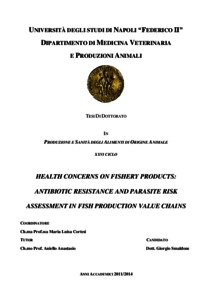Smaldone, Giorgio
(2014)
HEALTH CONCERNS ON FISHERY PRODUCTS: ANTIBIOTIC RESISTANCE AND PARASITE RISK ASSESSMENT IN FISH PRODUCTION VALUE CHAINS.
[Tesi di dottorato]
![[img]](http://www.fedoa.unina.it/9715/1.hassmallThumbnailVersion/HEALTH%20CONCERNS%20ON%20FISHERY%20PRODUCTS%20ANTIBIOTIC%20RESISTANCE%20AND%20PARASITE%20RISK%20ASSESSMENT%20IN%20FISH%20PRODUCTION%20VALUE%20CHAINS.pdf)  Anteprima |
|
Testo
HEALTH CONCERNS ON FISHERY PRODUCTS ANTIBIOTIC RESISTANCE AND PARASITE RISK ASSESSMENT IN FISH PRODUCTION VALUE CHAINS.pdf
Download (5MB)
| Anteprima
|
| Tipologia del documento: |
Tesi di dottorato
|
| Lingua: |
English |
| Titolo: |
HEALTH CONCERNS ON FISHERY PRODUCTS: ANTIBIOTIC RESISTANCE AND PARASITE RISK ASSESSMENT IN FISH PRODUCTION VALUE CHAINS |
| Autori: |
| Autore | Email |
|---|
| Smaldone, Giorgio | giorgio.smaldone@unina.it |
|
| Data: |
28 Marzo 2014 |
| Numero di pagine: |
273 |
| Istituzione: |
Università degli Studi di Napoli Federico II |
| Dipartimento: |
Medicina Veterinaria e Produzioni Animali |
| Scuola di dottorato: |
Scienze veterinarie per la produzione e la sanità |
| Dottorato: |
Produzione e sanità degli alimenti di origine animale |
| Ciclo di dottorato: |
26 |
| Coordinatore del Corso di dottorato: |
| nome | email |
|---|
| Cortesi, Maria Luisa | cortesi@unina.it |
|
| Tutor: |
| nome | email |
|---|
| Anastasio, Aniello | [non definito] |
|
| Data: |
28 Marzo 2014 |
| Numero di pagine: |
273 |
| Parole chiave: |
Antibiotic resistance, zoonotic desease,food safety. |
| Settori scientifico-disciplinari del MIUR: |
Area 07 - Scienze agrarie e veterinarie > VET/04 - Ispezione degli alimenti di origine animale |
| Aree tematiche (7° programma Quadro): |
BIOTECNOLOGIE, PRODOTTI ALIMENTARI E AGRICOLTURA > "Fork to farm" - Prodotti alimentari (inclusi prodotti ittici), salute e benessere |
[error in script]
[error in script]
| Depositato il: |
10 Apr 2014 10:27 |
| Ultima modifica: |
15 Lug 2015 01:01 |
| URI: |
http://www.fedoa.unina.it/id/eprint/9715 |

Abstract
Capture fisheries and aquaculture supplied the world with about 148 million tonnes of fish in 2010, of which about 128 million tonnes were utilized as food for people. The fishery market is becoming much more complex and stratified, with greater diversification among species and product forms and for this reason food safety remains a major concern facing the seafood industry. Along fish value chain there are a lot of concern regarding public health and for this reason the aim of this work was to propose an approach to antibiotic resistance and parasites risk assessment in fish production value chains.
The main consequences of the use and the abuse of antibiotics is the development and diffusion of antibiotic resistance that become a serious global problem. The aim of this research was to evaluate the presence of antimicrobial residues and to assess the antimicrobial resistance in bacteria species isolated from different wild caught seawater fish and fishery products. Three antibiotic substances (Oxytetracicline, Sulfamethoxazole and Trimethoprim) were detected (by screening and confirmatory methods) in Octopus vulgaris, Sepia officinalis and Thais haemastoma. All Vibrio strains isolated from fish were resistant to Vancomycin and Penicillin. In Vibrio alginolyticus, isolated in Octopus vulgaris, a resistance against 9 antibiotics was noted.
Human fishery product-borne parasitic diseases include those caused by cestodes, trematodes and nematodes. These diseases are either caused by an infection following ingestion of viable parasites, or as an allergic (hypersensitivity) reaction against parasite antigens which occurs for nematodes of the family Anisakidae.
Parasite risk assessment was evaluated in 3 different steps:
• Different infection indexes in european hakes (Merluccius merluccius) belonging from Atlantic ocean (FAO zone 27 IXa) and from Tyrrhenian sea (FAO zone 37.1.2) were assessed identifying and charactering species and populations of parasites. A total of 2990 larval specimens of A. simplex (s. l.) from Merluccius merluccius captured in the two different fishing grounds were collected: 2836 anisakids in hakes from FAO 27 fishing ground and only 154 anisakids in hakes from 37.1.2 fishing ground. A. simplex (s. s.) and A. pegreffii co-infected the same individual fish host, in viscera and in the fillets (hypaxial and epaxial) fished from the FAO 27 fishing ground; only A. pegreffii in hakes from FAO area 37.1.2 in viscera and in hypaxial flesh was found.
• The presence of nematodes in 33 fish species belonging from different FAO areas using artificial peptic digestion was evaluated and parasites identification using microscopical techniques and RT-PCR was performed. A total of 10897 anisakid larvae were found and collected in the flesh. The blue ling (Molva dypterygia), european conger (Conger conger) and Peter's fish (Zeus faber) were the most highly infected species respectively. A total of 27,27 % of the species analyzed were anisakid-free; a monitoring tool for the evaluation of parasite infection in fish lots with the aim to assess parasites impact on marketed fish, as EFSA states in a recent report, was applied; 29 % of the evaluated fish lots had a score between 0-3, refering to serious weaknesses in the fish lots.
• The survival of Anisakis larvae, naturally present in fish, at different stages of ripening process in traditional salted anchovies was evaluated since a recent EFSA panel on risk assessment of parasites in fishery products stated that research on identification of alternative treatments for killing viable parasites in fishery products are needed. Viability was tested with different methods and the results showed that all larvae were not viable at the 15th ripening day. The dry salting process at mean salt concentration of 24% in all parts of the flesh at the end of the ripening period can be considered an effective method for devitalising anisakids larval forms present in the raw material and obtain a safe product for the consumer.
Downloads per month over past year
Actions (login required)
 |
Modifica documento |





